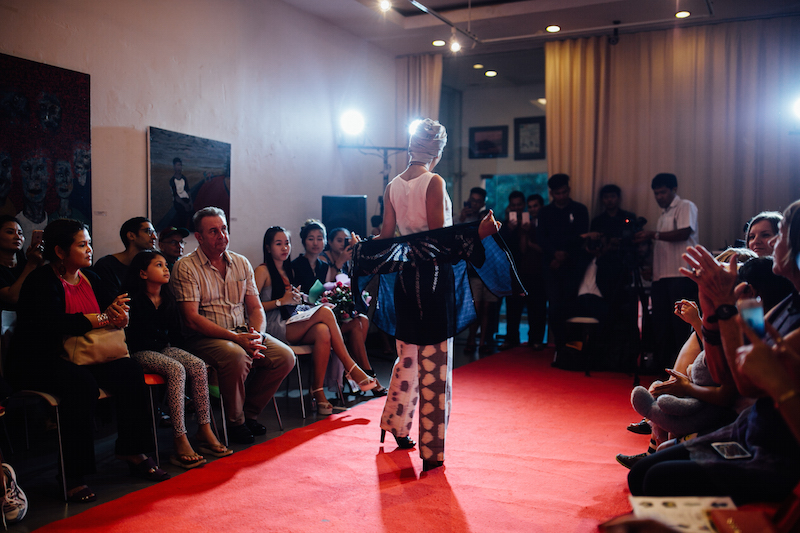Models draped in classic Cambodian textiles melded with modern designs strutted across the runway under the glare of spotlights as an enthralled audience showed their appreciation.
Meta House was the venue for a fashion event last night showcasing the work of fledgling designers from Phnom Penh’s Modern Ethnic Design Center (MEDC), the grand finale of its first yearlong program.

The center, initiated by the suPPPort sustainable development group with the Fashion Design Institute in Berlin, Raffles International College in Phnom Penh and Messe Berlin trade fair company, has been teaching students how to tap into the international market, blending Khmer and European design.
Throughout the last year, 14 Cambodian students have spent every Thursday and Friday learning to adapt traditional Cambodian fabrics and patterns for the European market, employ sustainable production practices and work with local suppliers. About half the students had been working in the garment or textile industry already while the other half came from Raffles International College.
Polham Seila, founder of Khmer Artisanry in Phnom Penh, said the program had given her inspiration.
“The program has shown me how to simplify patterns so they appeal to the foreigner. It’s somewhere in between traditional and modern,” said Ms. Seila, 38.
She’s had to make sacrifices to participate in the program while running her business—often staying up until midnight to finish products for clients after class. Her designs include patterns inspired by Angkor Wat and dragon scales, which she’s learned to incorporate into modern products.
The MEDC also helps students adjust their products to fit their target market. Since Ms. Seila’s naturally dyed fabrics are often above the local price range, she tailored her collection for 25- to 45-year-old foreigners. In the future, she hopes to bring her designs to the U.S. by selling them on Amazon.

Students are also given advice on how to capitalize on a growing international demand for unique, sustainably sourced products.
“These Cambodian designers have those kind of products, they just need to match that with what the international markets actually need,” said Ozan Oezdemir, managing director at suPPPort.
Anne Lonnes, a graduate from the Fashion Design Institute who instructed the course, said it focused on using traditional Cambodian weaving methods of silk and cotton, as well as patterns such as ikat (a dyeing technique), in the loose-fitting, casual-chic styles preferred in Europe at the moment.
Try Suphearac, who works for Watthan Artisans Cambodia, has been in the handicraft industry for almost 20 years but had never delved into the fashion sector. Now, he hopes to utilize the client base he’s already built to break into a new area.
Mr. Suphearac, 43, works with locally-sourced cotton, which he previously used for only scarves and blankets, for his casual lifestyle collection.
“The more I practiced in the program, the more ideas I’ve had,” said Mr. Suphearac. He hopes to build his brand locally before jumping into the international market.
From the fashion show last night, five students were chosen to showcase their products at Bazaar Berlin, an international sales show: Mr. Suphearac and Ms. Seila, along with Samnang Kang, Vannary Sang and Sam Ath Cheng, will head to Germany in November with all expenses paid.
“We want to help them have financial success in what they do,” said Mr. Oezdemir, of suPPPort. “That’s why we take them to a business-to-consumer trade fair so they can directly try the Berlin market.”
The program will also connect selected students with businesses in Berlin and online sustainable fashion retailers.
While it has three years of funding from the German government, Mr. Oezdemir said the program will work toward self-sustainability.
Before entering the MEDC program, Ms. Seila sold mostly fabric and scarves because she didn’t have any formal design training. The bits she did know came from watching YouTube videos and teaching herself.
“Now I know what to design, what Europeans like, and the language to describe my products,” she said. “This program has taught me everything.”



